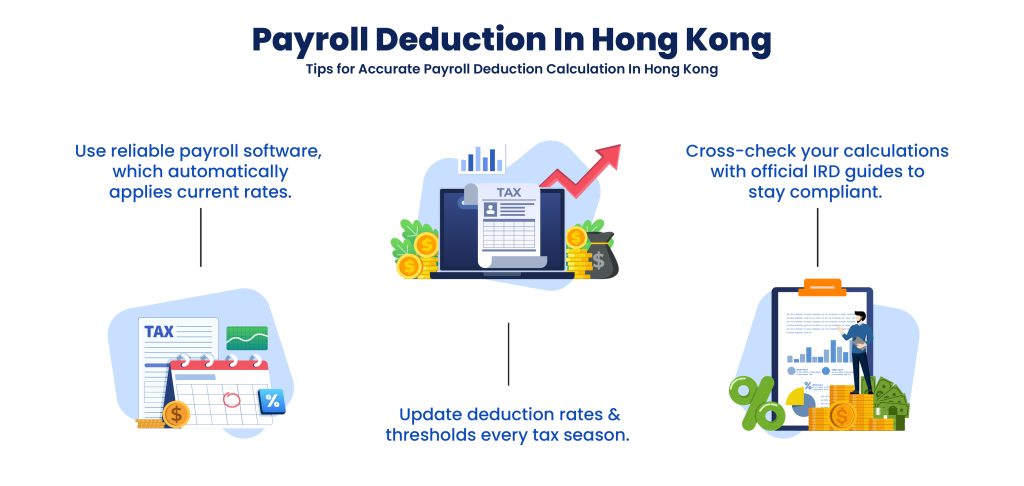Ever wondered more about payroll deduction in Hong Kong really means and how it affects your take-home pay? You’re not alone. Calculating salary deductions in Hong Kong involves various components each governed by specific regulations. Understanding payroll deduction in Hong Kong isn’t just a legal must—it’s a smart move for both employers and employees. In addition, it makes you stay compliant with local laws while keeping your finances in check. Whether you’re managing payroll or just curious about what’s coming out of your paycheck, if knowing on how deductions work can save you time, money, and unnecessary stress.
This guide explains with payroll deduction really with the types involved, and how to calculate them correctly.
What Is Payroll Deduction in Hong Kong?
Definition and Purpose
Payroll deductions are amounts that covers from the employee’s gross pay for necessary obligations and benefits. Eventually, these deductions cover mandatory contributions like MPF, taxes, and voluntary payments such as insurance or loans. It’s a way to compensate and fairly share that are contributed equally to social schemes or personal commitments. For employees it is a smart way to plan for retirement and other personal purposes. And whereas for employers, it avoids penalties and ensure compliance with local regulations.
Types of Payroll Deductions
- Statutory Deductions: – These can include mandatory payments required by Hong Kong law, such as MPF contributions, and salary tax followed by IRD.
- Voluntary Deductions: – They are optional and based on employee’s agreement. They may include health insurance, union fees, and loan repayments.
Legal Framework Governing Payroll Deduction
Hong Kong follows strict payroll deduction regulations for both employees and employers. The law mainly relies all in all on Employment Ordinances, Mandatory Provident Fund (MPF) Scheme, Occupational Retirement Scheme Ordinance (ORSO) and Inland Revenue Department (IRD). The IRD provides clear guidance on how taxes should be calculated, deducted and paid. Both employers and employees have defined rights and responsibilities knowing how much will be deducted and how much will be got approval for each voluntary deduction.
Automate Deductions. Simplify Compliance with Smart Payroll Software!
Components of Payroll Deduction In Hong Kong
Mandatory Contributions
Mandatory Provident Scheme Contributions
Employee earning for over HKD 7100, generally contributes based on the income thresholds. Both employer and employee must put in 5% of their relevant income, subject to caps. The cap is HKD 1,500 per month, so contributions stop once the limit is hit. MPF helps employees save for retirement, making these deductions essential.
To know more refer on the payroll compliance guide in Hong Kong and automate now.
Salaries Tax
In Hong Kong, salaries tax is deducted from employer withholding and paid directly to the IRD. The tax is based on income earned per year. Employees need to pay tax annually, whereas the employers need to deduct the tax and send to the government on time.
Voluntary deductions
Health, Life and Other Insurance Premiums
Employees often choose health insurances for their family members letting to deduct the premiums automatically. This needs clear consent, and proper documentation is required to avoid disputes. Employers should keep records of employee approval and payment arrangements.
Loan Repayments and Union Fees
Loans from banks or from any other lenders must be repaid from the salary account or else must be deducted from payroll as agreed upon. Similarly, union fees are deducted with employee approval. These deductions must be transparent, and employees should sign an agreement beforehand.
Your Trusted Payroll Outsourcing Partner for Payroll Accuracy in Hong Kong!
How to Calculate Payroll Deduction in Hong Kong
Step-by-Step Calculation Process
i. Collect Relevant Employee Salary Data
Start with the gross salary—this includes basic pay, bonuses, and allowances. Knowing the total helps you calculate deductions accurately.
ii. Identify Applicable Deduction Types
Check which deductions apply to the employee. For example, do they participate in the MPF scheme? Do they have voluntary deductions like health insurance? Listing each deduction avoids mistakes.
iii. Apply Contribution and Deduction Rates
Use current rates offered by government bodies. For MPF, multiply relevant income by 5% (or the capped amount). For tax, estimate based on income brackets. Remember to adjust for income thresholds and caps.

An Example of Payroll Deduction Calculation
Planning to outsource your employee’s payroll? Know more about payroll outsourcing and safeguard your valuable time to strategic activities.
Suppose an employee earns HKD 25,000 per month:
- MPF contribution: 5% of HKD 25,000 = HKD 1,250 (below cap).
Step 1: Determine Gross Income
- Basic Monthly Salary: HKD 25,000
- Annual Salary: HKD 25,000 × 12 = HKD 300,000
Step 2: Calculate MPF Contributions
- Employee Contribution: 5% of HKD 25,000 = HKD 1,250 per month (Capped at HKD 1,500, so no cap applied here)
- Annual Employee MPF Contribution: HKD 1,250 × 12 = HKD 15,000
✅ Deduct MPF from gross salary to get the net total income.
Step 3: Compute Net Total Income
- Annual Net Income = HKD 300,000 – HKD 15,000 = HKD 285,000
📌Step 4: Apply Personal Allowance
- Basic Allowance: HKD 132,000 (Standard for a single individual)
- Net Chargeable Income = HKD 285,000 – HKD 132,000 = HKD 153,000
📌Step 5: Calculate Salaries Tax
✅ Method 1: Progressive Tax Rates on Net Chargeable Income
| Income Bracket | Tax Rate | Tax Payable |
| First HKD 50,000 | 2% | HKD 1,000 |
| Next HKD 50,000 | 6% | HKD 3,000 |
| Next HKD 50,000 | 10% | HKD 5,000 |
| Remaining HKD 3,000 | 14% | HKD 420 |
| Total | HKD 9,420 |
✅ Method 2: Standard Rate (15%) on Net Total Income
- HKD 285,000 × 15% = HKD 42,750
✅ Select the lower amount → Salaries Tax Payable = HKD 9,420
📌Step 6: Calculate Final Take-Home Pay
| Description | Amount (HKD) |
| Annual Gross Income | 300,000 |
| – MPF Contributions | (15,000) |
| – Salaries Tax | (9,420) |
| Final Take-Home Pay | 275,580 |
✅ Final Result = Monthly Take-Home= HKD275,580/12 = HKD22,965
Tips for Accurate Payroll Deduction Calculation In Hong Kong

- Use reliable payroll software, which automatically applies current rates.
- Update deduction rates and thresholds every tax season.
- Cross-check your calculations with official IRD guides to stay compliant.
Seamless Payroll Deductions Within a Smarter HR Software!
Best Practices for Employers for Payroll Deduction
Maintaining Accurate Records
Keep clear records of all deductions and employee approvals. Thus, maintaining accurate documentation helps avoid legal issues down the line. As a result, it is important to store these records securely for at least 7 years, as recommended by Hong Kong law.
Ensuring Employee Consent
In addition, always get written consent before making voluntary deductions. Provide clear explanations about the deductions’ purpose and amount. This builds trust and keeps legal compliance straightforward.
Auditing and Reporting Requirements
Regularly review your payroll to catch errors early. Report deductions promptly to IRD and MPF schemes. Staying compliant prevents penalties and keeps your business reputation intact.
Common Challenges and Mistakes in Payroll Deduction
Miscalculations and Over/Under Deduction
Mistakes can happen when rates change or data is outdated. Over deduction can upset employees, that can under deduction may lead to penalties.
Non-compliance with Regulations
Failing to follow laws about mandatory contributions can lead to fines or legal actions. It’s vital to stay updated with recent changes from authorities.
Poor Record-Keeping
Sloppy records can cause confusion during audits and delay payments to authorities. Invest in good payroll practices and document everything.
Key Takeaways ꟷ Shape Tomorrow with Smart Decision
Payroll deduction in Hong Kong is a vital part of employment and tax compliance. It involves carefully deducting statutory and voluntary payments from employee wages. To get it right, gather accurate data, apply current rates, and keep thorough records.
Staying informed about legal updates and using reliable tools make payroll easier and safer. Seek your doubts with our experts by contacting us now over clicking here!

